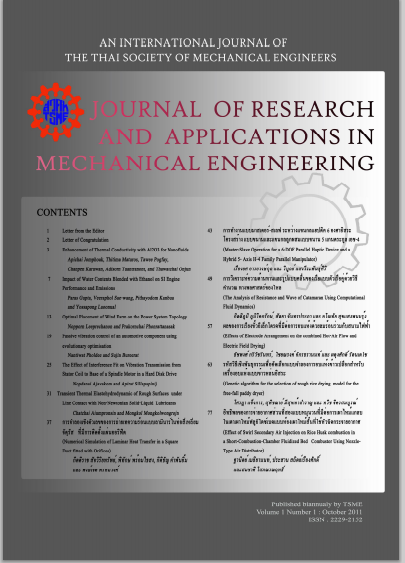Influence of elastic modulus change by springback prediction of high strength steel
Main Article Content
Abstract
The springback is caused by the release of residual stresses in a work piece after forming process. Especially, the springback effect is severe by forming high strength steel sheet. A success of the springback prediction using Finite Element (FE) forming simulation strongly depends on the applied materials model. Among various parameters of the model, elastic modulus is one of the most important factors influencing the calculation accuracy that should be considered as a function of strain. In this work, two different material models, the Hill48 and Yoshida-Uemori model were used. For both models, constant and varied elastic moduli were defined. Experimentally and numerically resulted springback of a hat shape stamped part were compared. Considering the elastic modulus change improved the accuracy of the springback prediction. The Yoshida-Uemori model showed better predictions than the Hill48 model in all cases.
Article Details
This work is licensed under a Creative Commons Attribution-NonCommercial-ShareAlike 4.0 International License.
References
[2] Vin, L.J., Streppl, A.H. and Singh, U.P. (1996). A process model for air bending, Journal of Materials Processing Technology, vol. 56, pp. 48–54.
[3] Morestin, F., Boivin, M. and Silva, C. (1996).Elastoplastic formulation using a kinematic hardening model for spring-back analysis in sheetmetal forming, Journal of Materials Processing Technology, vol. 56, pp. 619–630.
[4] Morestin, F. and Boivin, M. (1996). On the necessity of taking into account the variation in Young’s modulus with plastic strain in elastic– plastic software, Nuclear Engineering and Design, vol. 162, pp. 107–116.
[5] Cleveland, R. and Ghosh, A. (2002).Inelastic effects on springback in metals, International Journal of Plasticity, vol. 18, pp. 769-785.
[6] Zang, S.L., Liang, J. and Guo, C. (2007). A constitutive model for spring-back prediction in which the change of Young’s modulus with plastic deformation is considered,
International Journal of Machine Tools & Manufacture, vol. 47, pp. 1791–1797
[7] Yu, H.Y. (2009). Variation of elastic modulus during plastic deformation and its influence on springback, Materials and Design, vol. 30, pp. 846-850.
[8] Abdel-Karim, M. (2011) Effect of elastic modulus variation during plastic deformation on uniaxial and multiaxialratchetting simulations, European Journal of Mechanics A/Solids, vol. 30, pp. 11-21.
[9] Yoshida, F., Uemori, T. and Fujiwara K. (2002).Elastic–plastic behavior of steel sheets underin-plane cyclic tension–compression at large strain, International Journal Plasticity,
vol.18, pp.633–659.
[10] LS-DYNA, Keyword User's Manual Version971 Vol.2: Material Models, Livermore Software Technology Corporation, California, USA, 2007.
[11] Chongthairungruang, B., Uthaisangsuk, V., Suranuntchai, S., Jirathearanat, S. (2012). Experimental and numerical investigation of springback effect for advanced high strength dual phase steel, Materials and Design, vol. 39, pp. 318-328.
[12] Ma, N., Umezu, Y., Watanabe, Y. and Ogawa, T. (2008).Springback Prediction by Yoshida-Uemori Model and Compensation of Tool Surface using JSTAMP, paper presented in proceedings of NUMISHEET 2008, Switzerland.



